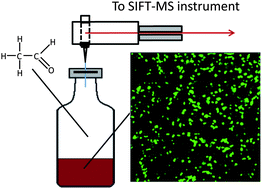
Sulé-Suso et al., Analyst, 2013, Advance Article
By Jennifer A. Dougan, Imperial College London, Web Writer
Lung cancer has a poor survival rate worldwide and research to better diagnose and manage the disease is of paramount importance. Recent work by Josep Sulé-Suso’s group from the Institute for Science and Technology in Medicine, based at Keele University attempts to improve our understanding of the behaviour of lung cancer. The approach taken by the group and a collaborator from the J. Heyrovský Institute of Physical Chemistry in the Czech Republic, was to analyse the volatile components (VCs) excreted from lung cancer cells and compare those to healthy lung cells using Selected Ion Flow Tube Mass Spectrometry, SIFT-MS. However, rather than analysing the headspace produced from a 2D growth of cells, the researchers aimed to mimic more closely the in vivo conditions by hosting the cells in a 3D hydrogel scaffold. They found that moving from a 2D to 3D system did, indeed, have an effect on the levels of VCs for both cancerous and non-cancerous cells and that they were able to discriminate between the two cell types at some concentrations. Although there is a way to go before SIFT-MS analysis reaches its ultimate aim; the analysis, diagnosis and management of lung cancer from patient exhalations, its ability to analyse multiple compounds simultaneously in humid air samples makes it an attractive technique for further studies. To read more about this HOT new Analyst article click below, it will be free to read until Dec 6th.
Quantification by SIFT-MS of acetaldehyde released by lung cells in a 3D model
Abigail V. Rutter, Thomas W. E. Chippendale, Ying Yang, Patrik Španěl, David Smith and Josep Sulé-Suso
Analyst, 2013, Advance Article
DOI: 10.1039/C2AN36185J










